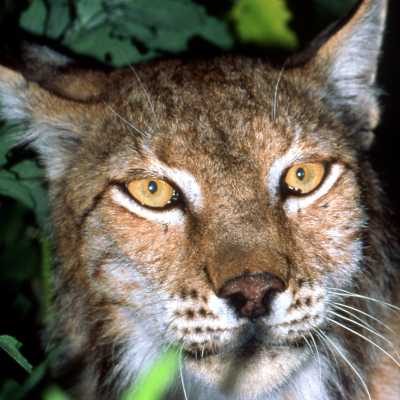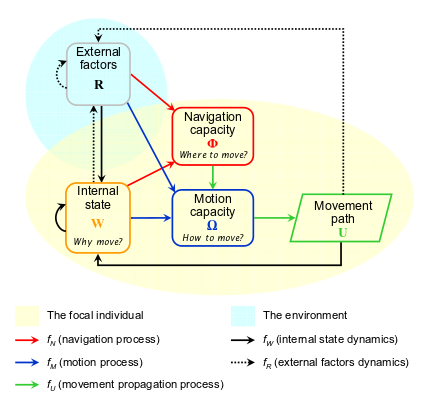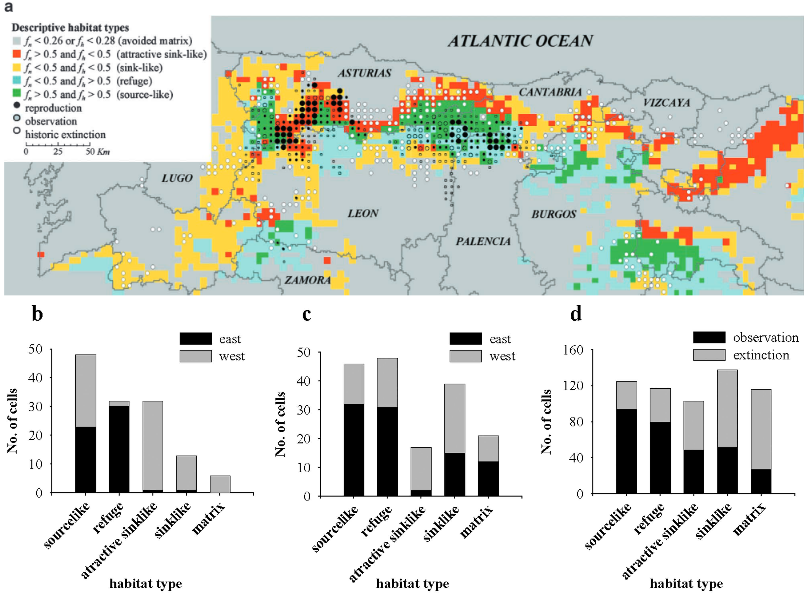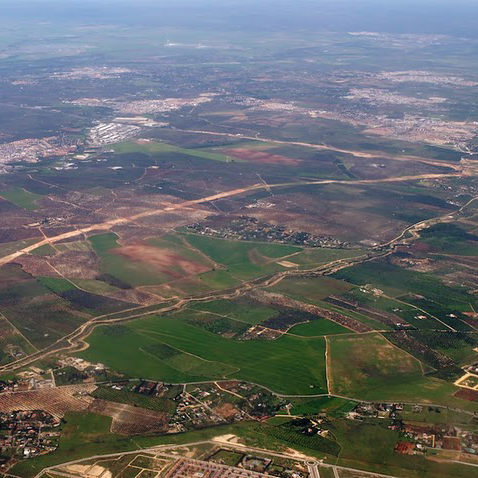 mechanistic spatial ecology
mechanistic spatial ecology
research ( species | space | populations | vulnerability | traffic )
 Sooner or later, the proper understanding of the ecology of a species requires moving down into individual responses, into the mechanisms and trade offs involved in the interaction between individuals and of those with the environment. The environment and the spatial distribution of other individuals is heterogeneous, imposing a differential use of space, with profound consequences at all levels. One of the most difficult parts of spatial ecology is understanding how individuals move in a way that gives us some prediction ability. And the challenge is there for all the activities that an individual may perform, during foraging, mate or refuge searching, patrolling, during excursions, dispersal events and migrations. The rarer the event, the stronger the difficulty, making the study of dispersal and specially the spatial prediction of its outcome a very tempting topic. As examples, I can cite here the works we did on the spatial organization and space use (for several species such us badgers, lynx, bears, ungulates etc), and the work on dispersal in fragmented landscapes (mostly with Iberian and Eurasian lynx).
Sooner or later, the proper understanding of the ecology of a species requires moving down into individual responses, into the mechanisms and trade offs involved in the interaction between individuals and of those with the environment. The environment and the spatial distribution of other individuals is heterogeneous, imposing a differential use of space, with profound consequences at all levels. One of the most difficult parts of spatial ecology is understanding how individuals move in a way that gives us some prediction ability. And the challenge is there for all the activities that an individual may perform, during foraging, mate or refuge searching, patrolling, during excursions, dispersal events and migrations. The rarer the event, the stronger the difficulty, making the study of dispersal and specially the spatial prediction of its outcome a very tempting topic. As examples, I can cite here the works we did on the spatial organization and space use (for several species such us badgers, lynx, bears, ungulates etc), and the work on dispersal in fragmented landscapes (mostly with Iberian and Eurasian lynx).
Revilla, E, T. Wiegand, F. Palomares, P. Ferreras & M. Delibes (2004) Effects of matrix heterogeneity on animal dispersal: from individual behavior to metapopulation-level parameters. The American Naturalist 164:E130-153
Kramer-Schadt S, E Revilla, T Wiegand & U Breitenmoser (2004) Fragmented landscapes, road mortality and patch connectivity: modelling influences on the dispersal of the Eurasian lynx. Journal of Applied Ecology 41:711-723
Ferreras, P., M. Delibes, F. Palomares, J.M. Fedriani, J. Calzada & E. Revilla. (2004) Proximate and ultimate causes of dispersal in the Iberian lynx Lynx pardinus. Behavioral Ecology: 15: 31-40
Delgado MM, V Penteriani, E Revilla, VO Nams (2010). The effect of phenotypic traits and external cues on natal dispersal movements. Journal of Animal Ecology 79: 620-632
Eurasian lynx photo by Antonio Sabater
 In the end, as all individuals of all species on Earth move from at least once in their lifetime to all the time, it was clear that a conceptual unification for all the disciplines dealing with movement was needed. An the new concept of movement ecology showed up. What is that? Just individual based spatially explicit spatial ecology. The key issue for me is the explicit recognition of movement as a relevant process in ecology, long neglected due to the challenges we face when studying it, and the identification of the key components in which we can conceptualize the movement of any organism. Here I can cite the papers in which we proposed the new movement ecology paradigm and some examples if its application.
In the end, as all individuals of all species on Earth move from at least once in their lifetime to all the time, it was clear that a conceptual unification for all the disciplines dealing with movement was needed. An the new concept of movement ecology showed up. What is that? Just individual based spatially explicit spatial ecology. The key issue for me is the explicit recognition of movement as a relevant process in ecology, long neglected due to the challenges we face when studying it, and the identification of the key components in which we can conceptualize the movement of any organism. Here I can cite the papers in which we proposed the new movement ecology paradigm and some examples if its application.
Nathan R, WM Getz, E Revilla, M Holyoak, R Kadmon, D Saltz, PE Smouse. (2008) A Movement Ecology Paradigm for Unifying Organismal Movement Research. Proceedings of the National Academy of Sciences USA 105:19052-19059
Holyoak M, R Casagrandi, R Nathan, E Revilla, O Spiegel. (2008) Trends and missing parts in the study of movement ecology. Proceedings of the National Academy of Sciences USA 105:19060-19065 suppl. matherial
Martin J, B van Moorter, E Revilla, P Blanchard, S Dray, P-Y Quenette, D Allaine, JE Swenson (2013). Reciprocal modulation of internal and external factors determine female brown bear movements. Journal of Animal Ecology 82:290-300. doi:10.1111/j.1365-2656.2012.02038.x
 Individuals move in a space that is heterogeneous for many relevant factors that can affect their fitness. Mapping that heterogeneity is a very relevant task, as it is projecting it under different scenarios. What can you map? From the most general habitat where a species can settle and reproduce to those required to move across a matrix of unsuitable landscape, to areas with differential risk of mortality, food abundance etc. Potential habitat modeling (a part of which is nowadays called niche modeling in a revival of an already established research topic) is very much linked with the work on the use and selection of resources at species level. How can you do it? There are dozens of ways, all of them with advantages and disadvantages, from simple but very effective rule based approaches to more or less sophisticated statistical descriptions, including also multidimensional models each for a given demographic process and that can be used when the environmental factors differentially affecting each demographic process can be independently mapped (lots of potential).
Individuals move in a space that is heterogeneous for many relevant factors that can affect their fitness. Mapping that heterogeneity is a very relevant task, as it is projecting it under different scenarios. What can you map? From the most general habitat where a species can settle and reproduce to those required to move across a matrix of unsuitable landscape, to areas with differential risk of mortality, food abundance etc. Potential habitat modeling (a part of which is nowadays called niche modeling in a revival of an already established research topic) is very much linked with the work on the use and selection of resources at species level. How can you do it? There are dozens of ways, all of them with advantages and disadvantages, from simple but very effective rule based approaches to more or less sophisticated statistical descriptions, including also multidimensional models each for a given demographic process and that can be used when the environmental factors differentially affecting each demographic process can be independently mapped (lots of potential).
Schadt, S., F. Knauer, P. Kaczensky, E. Revilla, T. Wiegand, & L. Trepl (2002). Rule-based assessment of suitable habitat and patch connectivity for the Eurasian lynx. Ecological Applications 12: 1469-1483
Schadt, S., E. Revilla, T. Wiegand, F. Knauer, P. Kaczensky, U. Breitenmoser, L. Bufka, J. Cerveny, T. Huber, C. Stanisa & L. Trepl (2002) Assessing the suitability of central European landscapes for the reintroduction of Eurasian lynx. Journal of Applied Ecology 39: 189-203
Naves J, T Wiegand, E Revilla & M Delibes (2003) Endangered species constrained by natural and human factors: the case of brown bears in Northern Spain Conservation Biology 17: 1276-1289
 And the results of all these models can be described in terms of the habitat that remains available, the amount of habitat loss, its fragmentation and the effect on some population properties, such as density or abundance. All of these applications have a clear application in conservation biology (even though sometimes practitioners do not want to see it, those still relying only on their personal gut-feeling...).
And the results of all these models can be described in terms of the habitat that remains available, the amount of habitat loss, its fragmentation and the effect on some population properties, such as density or abundance. All of these applications have a clear application in conservation biology (even though sometimes practitioners do not want to see it, those still relying only on their personal gut-feeling...).
Martin J, E Revilla, P-Y Quenette, J Naves, D Allaine, JE Swenson (2012). Brown bear habitat suitability in the Pyrenees: transferability across sites and linking scales to make the most of scarce data. Journal of Applied Ecology 49:621-631 doi:10.1111/j.1365-2664.2012.02139.x
Wiegand T., E. Revilla, & K. A. Moloney. (2005) Effects of habitat loss and fragmentation on population dynamics. Conservation Biology 19:108-121
Revilla, E., F. Palomares & M. Delibes, M. (2001) Edge-core effects and the effectiveness of traditional reserves in conservation: Eurasian badgers in Doñana National Park. Conservation Biology 15: 148-158
